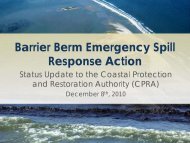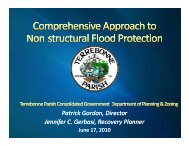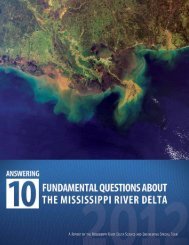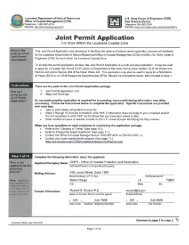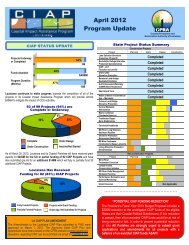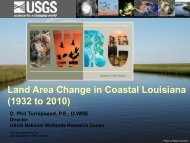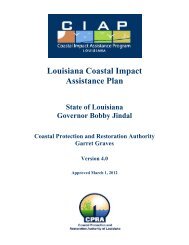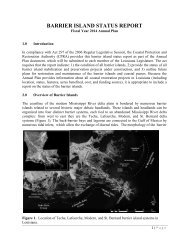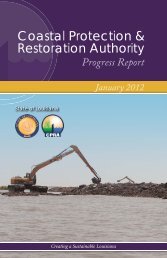Largemouth Bass Habitat Suitability Index Technical Report
Largemouth Bass Habitat Suitability Index Technical Report
Largemouth Bass Habitat Suitability Index Technical Report
Create successful ePaper yourself
Turn your PDF publications into a flip-book with our unique Google optimized e-Paper software.
APPENDIX D‐9 LARGEMOUTH BASS HABITAT SUITABILITY INDEX TECHNICAL REPORTe. Description of Output DataThis model will output a habitat suitability index from 1.0 to 0 for each 500 x 500m cell with 1.0indicating very high suitability of habitat for largemouth bass.f. Statement on the capabilities and limitations of the modelThis model is adequate for assessing habitat suitability in response to changes in salinity. As aspecies group, largemouth bass are quite temperature tolerant ranging from Mexico and PuertoRico north into Canada, although individuals may not have wide tolerance ranges. Further,largemouth bass are quite adaptable to a variety of physical habitats, as evidenced by theirsuccessful introduction in a wide variety of geomorphological habitats from Japan to Puerto Ricoand Mexico. Thus, temperature and habitat are rarely restricting stressors to largemouth bassbut may cause mortality through cumulative negative physiological impacts from unsuitablehabitat and high or low temperatures. In this model, poor habitat or extremes in temperature ascombined stressors result in low probability of habitat use, thus, mathematically representingthe physiological impacts from poor habitat and temperature. Because largemouth bass areadapted to the osmoregulatory challenges of freshwater (i.e., retaining ions in an ion‐poorsolution), these fish experience stress and eventual mortalities at high salinities. This model willpredict unsuitable habitat for bass in scenarios where salinity increases and suitable habitat inscenarios where salinities decrease, as well as, identifying poor quality habitat or temperaturesthrough low probabilities of use.The model has three serious limitations that, given the available data, are impossible to includein the model. First, these fish have strong behavioral tendencies, which result in fish that arehighly territorial, actively seeking physical structures (e.g., woody debris, docks, vegetation), andactively avoiding deep water (i.e., most bass are found in less than 3 meters). Modeling thisbehavioral aspect is not possible, given that depth data are not available and the model onlyworks on presence/absence lacking the density data necessary to determine territorialsegregation. Second, largemouth bass do not thrive in habitats with high densities of predators,such as alligator gar or alligators. Although alligator data could be available, the nature of thisrelationship is more anecdotal than quantitatively described. Lastly, largemouth bass avoid lowlevels of dissolved oxygen or suffer mortality, if avoidance is impossible. <strong>Largemouth</strong> bass maytolerate brief excursions below 1 mg/L; however, fish commonly become stressed whendissolved oxygen is consistently below 2 mg/L and will experience mortality if these conditionspersist or if dissolved oxygen plummets to near zero. These data are not available as inputs tothe model. Consequently, the model may err in prediction based on largemouth bass behavior,predatory pressures, and effects of low dissolved oxygen.g. Description of model development process including documentation on testing conducted(Alpha and Beta tests)1. CPRA identified largemouth bass for inclusion as a target species for the ecosystem servicemodeling.2. The original HSI for largemouth bass by Stuber (1982) was retrieved. Stuber’s (1982) HSIincluded 22 variables that described four primary habitat selection factors, which were food,cover, water quality, and reproduction. Food was described by a total dissolved solidsvariable. Cover was described as % area greater than 6 m deep, % bottom cover, and twowater level fluctuation variables. Water quality was described by dissolved oxygen, pH,temperature, turbidity, and two salinity variables. Reproduction was described by % areagreater than 6 m deep, temperature, salinity, substrate, and water level fluctuationLouisiana’s Comprehensive Master Plan for a Sustainable CoastPage 3



